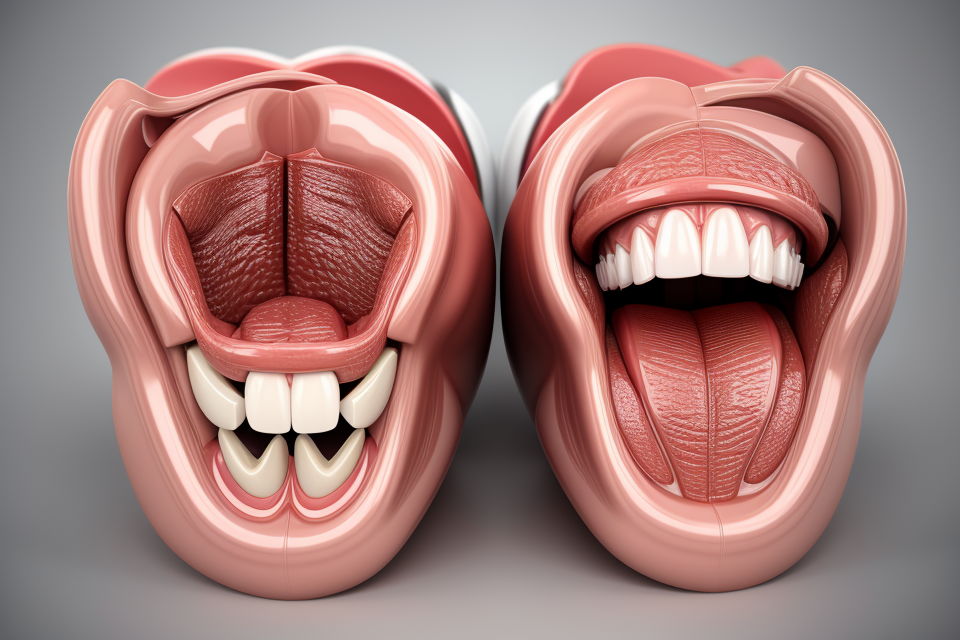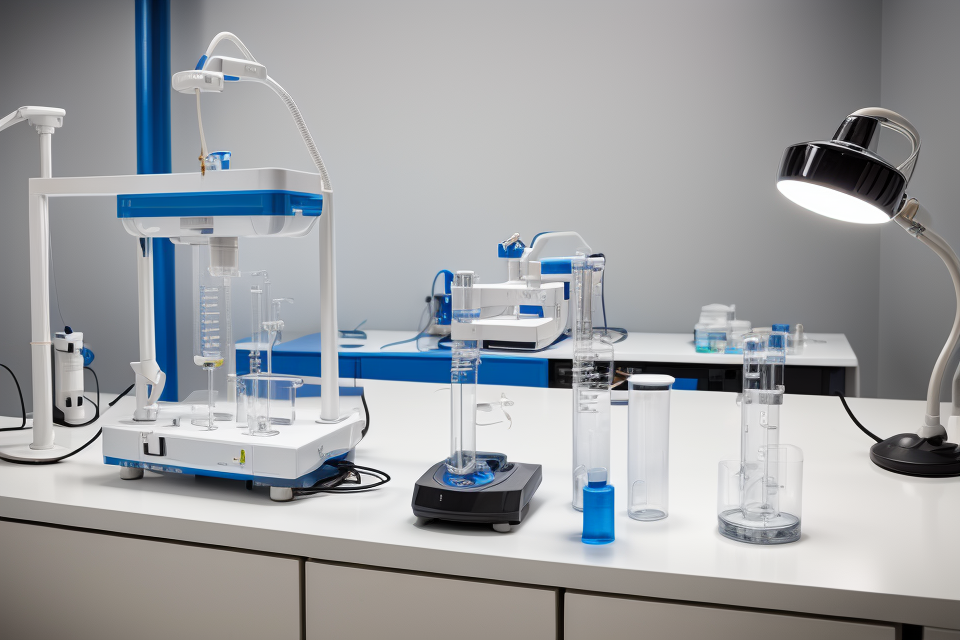Description: This article explores the reasons behind the design of mouthguards and why they only cover the top teeth. It delves into the anatomy of the teeth and the role of the mouthguard in protecting them during physical activity. The article also discusses the potential drawbacks of this design and how it can be improved for better protection.
Mouthguards are protective devices worn over teeth during physical activities such as sports, to prevent injuries to the teeth and mouth. But have you ever wondered why mouthguards only cover the top teeth? Is it because the bottom teeth are not important or are they designed to protect only the top teeth? In this article, we will explore the purpose and design of mouthguards and why they are designed to cover only the top teeth.
The Anatomy of the Teeth
Types of Teeth
When it comes to understanding the purpose and design of mouthguards, it is essential to know the different types of teeth that are present in the human mouth. There are four main types of teeth: incisors, canines, premolars, and molars.
- Incisors: These are the front teeth that are used for biting and cutting food. There are two incisors in the upper jaw and two in the lower jaw, with a total of four incisors in the mouth.
- Canines: Also known as cuspids, these teeth are located next to the incisors and are used for tearing and shredding food. There are two canines in the upper jaw and two in the lower jaw, with a total of four canines in the mouth.
- Premolars: These teeth are located behind the canines and are used for crushing and grinding food. There are two premolars in the upper jaw and two in the lower jaw, with a total of four premolars in the mouth.
- Molars: These are the largest teeth in the mouth and are located behind the premolars. They are used for grinding and chewing food. There are two molars in the upper jaw and two in the lower jaw, with a total of four molars in the mouth.
Understanding the different types of teeth is crucial in determining the purpose and design of mouthguards. For instance, mouthguards are designed to protect the teeth during physical activity, and knowing the location and function of each tooth can help in creating a custom-fitted mouthguard that provides optimal protection.
Importance of Teeth
- Chewing and breaking down food: The teeth play a crucial role in the process of chewing and breaking down food, which is essential for proper digestion. The teeth are designed to work together with the jaw muscles to chop, crush, and grind food into smaller pieces, making it easier to swallow and digest.
- Speaking and communication: The teeth are also essential for speech and communication. They help to form the sounds and words that we use to express ourselves, and without our teeth, speaking and communicating would be significantly more difficult.
- Support for the lips and cheeks: In addition to their functional roles, the teeth also provide support for the lips and cheeks. They help to hold the lips in place and keep them from sagging, and they also provide support for the cheeks, which helps to give the face its shape and structure.
The Purpose of Mouthguards
Protecting Teeth During Physical Activity
- Sports-related injuries
- Grinding and clenching of teeth
Protecting Teeth During Physical Activity
Mouthguards are designed to protect teeth during physical activity. They serve as a barrier between the teeth and any potential impact or trauma that may occur during sports or other activities.
Sports-related Injuries
Sports-related injuries are a common reason why mouthguards are used. These injuries can include collisions, falls, and other accidents that can cause damage to the teeth and mouth. Wearing a mouthguard can help absorb the impact of these injuries, reducing the risk of broken teeth, cuts, and other injuries to the mouth.
Grinding and Clenching of Teeth
Another reason why mouthguards are used is to protect against the grinding and clenching of teeth. This condition, known as bruxism, can cause significant damage to the teeth and jaw over time. Wearing a mouthguard can help reduce the pressure on the teeth and prevent further damage.
It is important to note that mouthguards are not a one-size-fits-all solution. They are custom-made to fit the individual’s teeth and mouth, ensuring maximum protection during physical activity. It is also recommended to wear a mouthguard during any activity that may pose a risk to the teeth and mouth, not just during sports.
Reducing Impact and Pressure on Teeth
When it comes to protecting one’s teeth, mouthguards play a crucial role. These devices are designed to reduce the impact and pressure on teeth during physical activities, such as sports or martial arts. By absorbing and distributing force, mouthguards protect against trauma and injury to the teeth, jaws, and mouth.
Absorbing and Distributing Force
One of the primary functions of a mouthguard is to absorb and distribute force. This means that when a person wears a mouthguard, the guard absorbs the impact of a blow or collision and distributes the force evenly across the teeth and jaws. This helps to reduce the risk of teeth being knocked out or injured, as well as preventing damage to the jaw and other facial structures.
Protecting Against Trauma and Injury
In addition to reducing the impact and pressure on teeth, mouthguards also protect against trauma and injury. This is particularly important for athletes and individuals who participate in contact sports, as they are at a higher risk of sustaining injuries to their teeth and mouth. By wearing a mouthguard, these individuals can significantly reduce their risk of sustaining injuries, such as broken teeth, cuts, and bruises.
It is important to note that not all mouthguards are created equal. The design and material of a mouthguard can impact its effectiveness in reducing impact and pressure on teeth. For example, custom-fitted mouthguards are generally more effective than store-bought ones, as they are tailored to fit the individual’s teeth and jaws. Additionally, mouthguards made from thicker and more durable materials are typically better at absorbing and distributing force.
Overall, mouthguards play a crucial role in protecting teeth and mouths during physical activities. By reducing the impact and pressure on teeth, and protecting against trauma and injury, mouthguards are an essential piece of equipment for anyone who participates in sports or other physical activities.
The Design of Mouthguards
Custom-Fitted vs. Stock Mouthguards
Custom-fitted mouthguards and stock mouthguards are the two primary types of mouthguards available for athletes and individuals who require protection for their teeth. Both types of mouthguards have their unique advantages and disadvantages, and the choice between them depends on various factors.
Custom-fitted mouthguards
Custom-fitted mouthguards are specially designed and fabricated to fit an individual’s teeth and mouth perfectly. These mouthguards are made by dentists or professional dental laboratories using a mold or impression of the patient’s teeth. The mold is then used to create a custom-fitted mouthguard that fits the individual’s teeth and mouth perfectly, providing maximum protection and comfort.
One of the main advantages of custom-fitted mouthguards is that they offer superior protection to the teeth and mouth. Since they are designed specifically for an individual’s teeth and mouth, they fit perfectly and provide maximum protection against injuries and impacts. Additionally, custom-fitted mouthguards are usually more comfortable to wear than stock mouthguards, as they are designed to fit the individual’s mouth and teeth perfectly.
However, custom-fitted mouthguards are also more expensive than stock mouthguards, and they require a dental examination and fitting appointment to create the mold or impression. Additionally, custom-fitted mouthguards may not be covered by insurance, which can make them unaffordable for some individuals.
Stock mouthguards
Stock mouthguards are pre-made mouthguards that are available in a variety of sizes and styles. These mouthguards are typically made of a thermoplastic material that can be heated and molded to fit the individual’s teeth and mouth. Stock mouthguards are readily available at sporting goods stores and online retailers and are typically less expensive than custom-fitted mouthguards.
One of the main advantages of stock mouthguards is their affordability and accessibility. Since they are pre-made and readily available, they can be purchased without the need for a dental examination or fitting appointment. Additionally, stock mouthguards are typically less expensive than custom-fitted mouthguards, making them an attractive option for individuals who require a mouthguard but cannot afford a custom-fitted mouthguard.
However, stock mouthguards are not as effective at protecting the teeth and mouth as custom-fitted mouthguards. Since they are not designed specifically for an individual’s teeth and mouth, they may not fit perfectly, and there may be gaps or spaces between the mouthguard and the teeth, which can reduce their effectiveness. Additionally, stock mouthguards may be less comfortable to wear than custom-fitted mouthguards, as they may not fit the individual’s mouth and teeth perfectly.
Materials Used in Mouthguards
Mouthguards are typically made from a variety of materials, each with its own unique properties that make it suitable for a specific purpose. Some of the most commonly used materials in mouthguards include thermoplastic, polyvinyl chloride (PVC), and polyurethane (PU).
Thermoplastic is a type of plastic that can be melted and reshaped multiple times. This makes it an ideal material for mouthguards because it can be customized to fit the individual’s teeth and mouth. Thermoplastic mouthguards are also durable and can withstand the force of impact during sports activities.
Polyvinyl chloride (PVC) is another common material used in mouthguards. PVC mouthguards are typically less expensive than thermoplastic mouthguards and are often used for casual sports activities. They are also lightweight and flexible, which makes them comfortable to wear. However, PVC mouthguards are not as durable as thermoplastic mouthguards and may not provide the same level of protection.
Polyurethane (PU) is a versatile material that is often used in the production of sports equipment. PU mouthguards are lightweight and flexible, making them comfortable to wear. They are also durable and can withstand the force of impact during sports activities. However, PU mouthguards are typically more expensive than PVC mouthguards and may not be as customizable as thermoplastic mouthguards.
Each of these materials has its own advantages and disadvantages, and the choice of material will depend on the individual’s needs and preferences. Ultimately, the most important factor in choosing a mouthguard is ensuring that it provides adequate protection during sports activities.
Covering Only the Top Teeth
Anatomy of the Teeth
The teeth are made up of different sections, including the crown, which is the visible part of the tooth, and the root, which is not visible and is embedded in the jawbone. The top teeth, also known as the incisors and canines, are the ones that are most visible when a person smiles. These teeth are designed to be very strong and durable, as they are the ones that are used for biting and chewing food.
Alignment of the Teeth
The teeth are aligned in a specific way, with the incisors and canines at the front of the mouth and the molars at the back. This alignment is important for proper biting and chewing, as well as for speech. The mouthguard’s design is tailored to fit this alignment, with the top teeth being the focus of protection.
Reducing Coverage and Bulk
Mouthguards are designed to be as thin and lightweight as possible, in order to be comfortable to wear and not interfere with speech or breathing. Covering only the top teeth allows for a more streamlined design, with less material and bulk. This makes the mouthguard more comfortable to wear and easier to speak and breathe with while wearing.
In conclusion, the design of mouthguards to only cover the top teeth is based on the anatomy and alignment of the teeth, as well as the need for a comfortable and streamlined design.
Potential Drawbacks of Mouthguards
Difficulty Speaking and Breathing
While mouthguards provide protection for the teeth and jaw during physical activity, they can also create difficulties with speaking and breathing. This is due to the limited mouth movement that is allowed by the mouthguard, which can cause difficulty with pronunciation and lead to an increased effort when speaking.
Limited mouth movement
Mouthguards are designed to fit snugly over the teeth, which can limit the range of motion of the jaw and tongue. This can make it difficult to speak and breathe properly, as the mouthguard can interfere with the normal movement of the tongue and lips.
Difficulty with pronunciation
The limited mouth movement caused by the mouthguard can also make it difficult to pronounce certain words correctly. This is because the mouthguard can change the position of the teeth and jaw, which can affect the way sounds are produced. This can be particularly challenging for individuals who wear braces or have other dental devices, as the mouthguard can further restrict their ability to speak and breathe properly.
Overall, while mouthguards are an important protective measure for athletes, they can also create difficulties with speaking and breathing. It is important for individuals who wear mouthguards to be aware of these potential drawbacks and to work with their dentist or orthodontist to find the best solution for their specific needs.
Discomfort and Adaptation
Mouthguards are designed to protect the teeth and mouth during physical activities, but they can also cause discomfort and adaptation issues for some individuals.
Dry mouth
One of the most common issues associated with mouthguards is dry mouth. This is because mouthguards can prevent the normal flow of saliva in the mouth, which can lead to discomfort and can also increase the risk of tooth decay and gum disease.
Jaw pain
Another potential drawback of mouthguards is jaw pain. Some individuals may experience pain or discomfort in their jaw or teeth while wearing a mouthguard, particularly if the mouthguard is not properly fitted or is too bulky. This can be caused by the increased pressure on the jaw and teeth, as well as the altered bite and jaw position.
It is important to note that these issues can often be alleviated by choosing a properly fitted mouthguard and taking steps to maintain good oral hygiene, such as drinking plenty of water and brushing and flossing regularly. However, individuals who experience persistent discomfort or pain while wearing a mouthguard should consult with a dentist or healthcare professional to determine the best course of action.
Improving the Design of Mouthguards
- Customization for individual teeth
- Digital scanning technology
- Accurate measurements
- Custom-fit design
- 3D printing
- Personalized mouthguards
- Improved fit and comfort
- Digital scanning technology
- Material advancements
- Biocompatible materials
- Reduced risk of allergic reactions
- Enhanced durability
- Lightweight materials
- Improved comfort
- Reduced fatigue
- Biocompatible materials
- Improved fit and comfort
- Thermoplastic material
- Flexible and adaptable to teeth and jaw movements
- Improved speech and breathing
- Removable design
- Easy to clean and maintain
- Increased compliance with wearing mouthguards
- Thermoplastic material
FAQs
1. Why do mouth guards only cover the top teeth?
Mouth guards are designed to protect the teeth from injury during physical activity, such as sports or other forms of impact. The teeth in the upper jaw are more prone to injury during impact, as they are more exposed and less protected by the lower jaw. As a result, mouth guards are designed to cover only the top teeth to provide the most protection.
2. Can a mouth guard be worn on the bottom teeth?
Mouth guards are not designed to be worn on the bottom teeth, as the teeth in the lower jaw are more protected by the upper jaw during impact. Wearing a mouth guard on the bottom teeth could actually cause more harm than good, as it could prevent the lower jaw from properly absorbing impact and could lead to injury.
3. What materials are mouth guards made of?
Mouth guards are typically made of a flexible, durable material such as rubber or plastic. Some mouth guards may also contain additional materials, such as foam or gel, to provide extra cushioning and comfort.
4. How do I properly wear a mouth guard?
To properly wear a mouth guard, first insert it into your mouth and bite down gently. The mouth guard should fit snugly over your teeth and be comfortable to wear. If the mouth guard is too loose or too tight, you may need to adjust it or try a different size. It’s important to wear the mouth guard during any physical activity to protect your teeth from injury.
5. How long does a mouth guard last?
The lifespan of a mouth guard can vary depending on factors such as the material it is made of and how often it is used. In general, a mouth guard should last for several months before needing to be replaced. It’s important to regularly inspect your mouth guard for signs of wear or damage and replace it as needed to ensure it continues to provide effective protection for your teeth.



